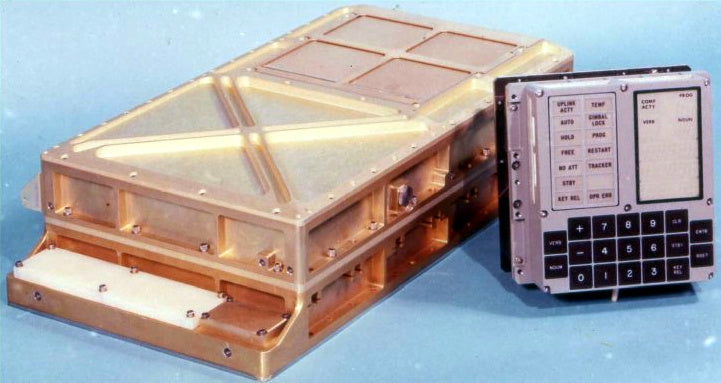

The Apollo Guidance Computer: A Technological Marvel and the Women Behind Its Memory
The Apollo Guidance Computer (AGC) stands as a testament to human ingenuity and engineering prowess. Developed during the 1960s as part of NASA's Apollo program, this revolutionary device played a critical role in enabling humankind's first footsteps on the moon. Behind its remarkable capabilities lies a story of remarkable women who played a crucial role in its creation. In this article, we will explore the technical marvel that was the Apollo Guidance Computer, highlighting its innovative features, impressive capabilities, and enduring impact and the pioneering efforts of women at the Raytheon Corporation, who painstakingly hand-wove the memory modules for the AGC.

One of the most remarkable aspects of the AGC was its compact size. At a time when computers occupied entire rooms, the AGC had to be reduced to fit within the limited space available on the Apollo spacecraft. To achieve this, engineers pioneered miniaturization techniques, resulting in a computer that weighed only 70 pounds. Additionally, a team of talented and dedicated women at the Raytheon Corporation played a vital role in the construction of the AGC. Tasked with weaving the memory modules, they meticulously threaded tiny magnetic cores through wire grids, creating the crucial magnetic core memory that formed the computer's primary storage.

The work of these women weavers at Raytheon was indispensable to the success of the Apollo missions. Their intricate craftsmanship ensured that the AGC had the necessary memory capacity to store critical data, including navigation algorithms, mission parameters, and guidance instructions. The AGC's memory modules, hand-woven by these skilled women, played a vital role in the navigation and safe landing of Apollo spacecraft on the moon, marking a significant milestone in human history.

Another key figure in the development of the Apollo Guidance Computer was computer scientist Margaret Hamilton. As the director of the Software Engineering Division at the MIT Instrumentation Laboratory, Hamilton led a team responsible for developing the software that powered the AGC. Her pioneering work in software engineering and her innovative approach to error detection and recovery were instrumental in ensuring the reliability and functionality of the AGC's software. Hamilton's rigorous testing and rigorous coding practices helped prevent potential errors and contributed to the success of the Apollo missions. Her groundbreaking contributions to the AGC's software programming have made her a legendary figure in computer science and an inspiration to future generations of programmers.

The AGC was primarily responsible for guiding the Apollo spacecraft during crucial mission phases, including lunar landings. Equipped with advanced navigation algorithms, the computer processed data from various sensors and instruments to calculate the spacecraft's position, velocity, and orientation in real-time. The AGC boasted an innovative operating system that allowed astronauts to interact with the computer efficiently. The user interface incorporated a digital display and a numeric keypad, enabling astronauts to input commands and monitor critical information.
Considering the high stakes of space travel, the AGC was designed to be fault-tolerant and capable of autonomous decision-making. It featured multiple redundant systems and error-checking mechanisms that ensured the computer's reliability, mitigating potential failures. Moreover, the AGC could autonomously respond to unexpected events and make real-time adjustments to mission parameters, augmenting the astronauts' decision-making capabilities and increasing overall mission safety. The legacy of the Apollo Guidance Computer extends far beyond the moon landings. Its cutting-edge technologies and engineering innovations paved the way for the development of subsequent generations of computers and computer systems. The lessons learned from the AGC's design and operation helped shape modern space exploration technology and found applications in various industries on Earth.

Today, the legacy of the AGC lives on in various museums worldwide, providing visitors with a glimpse into the marvels of early space technology. Museums like the Smithsonian National Air and Space Museum, the Computer History Museum, the Kennedy Space Center Visitor Complex, and the Science Museum proudly exhibit AGCs, showcasing the technical prowess of the AGC and honoring the women who contributed to its creation. The story of the women weavers at Raytheon highlights the often overlooked contributions of women in technology and space exploration. Their dedication and expertise were vital to the success of the AGC and the Apollo program as a whole. By recognizing and celebrating their achievements, we not only honor their legacy but also inspire the next generation of women to pursue careers in STEM fields, leaving an indelible mark on the future of innovation.

The Apollo Guidance Computer was a true technical marvel of its time, pushing the boundaries of what was possible in computing and space exploration. Its miniaturization, reliability, guidance and navigation capabilities, user interface design, fault tolerance, and autonomy set new standards for future generations of computers. The AGC owes its success not only to its groundbreaking technology but also to the talented women at the Raytheon Corporation who meticulously hand-wove its memory modules. Their invaluable contributions ensured the reliability and functionality of the AGC, paving the way for human space exploration. Through the preservation of AGCs in museums worldwide, the legacy of these women and the AGC's significance in history are upheld, inspiring generations to come and highlighting the crucial role of women in shaping the world of technology. The Apollo Guidance Computer and the women behind its memory serve as a powerful symbol of human achievement and the remarkable feats that can be accomplished through technological innovation and gender equality.
Shop our Core Memory collection inspired by the Apollo Guidance Computer here.





